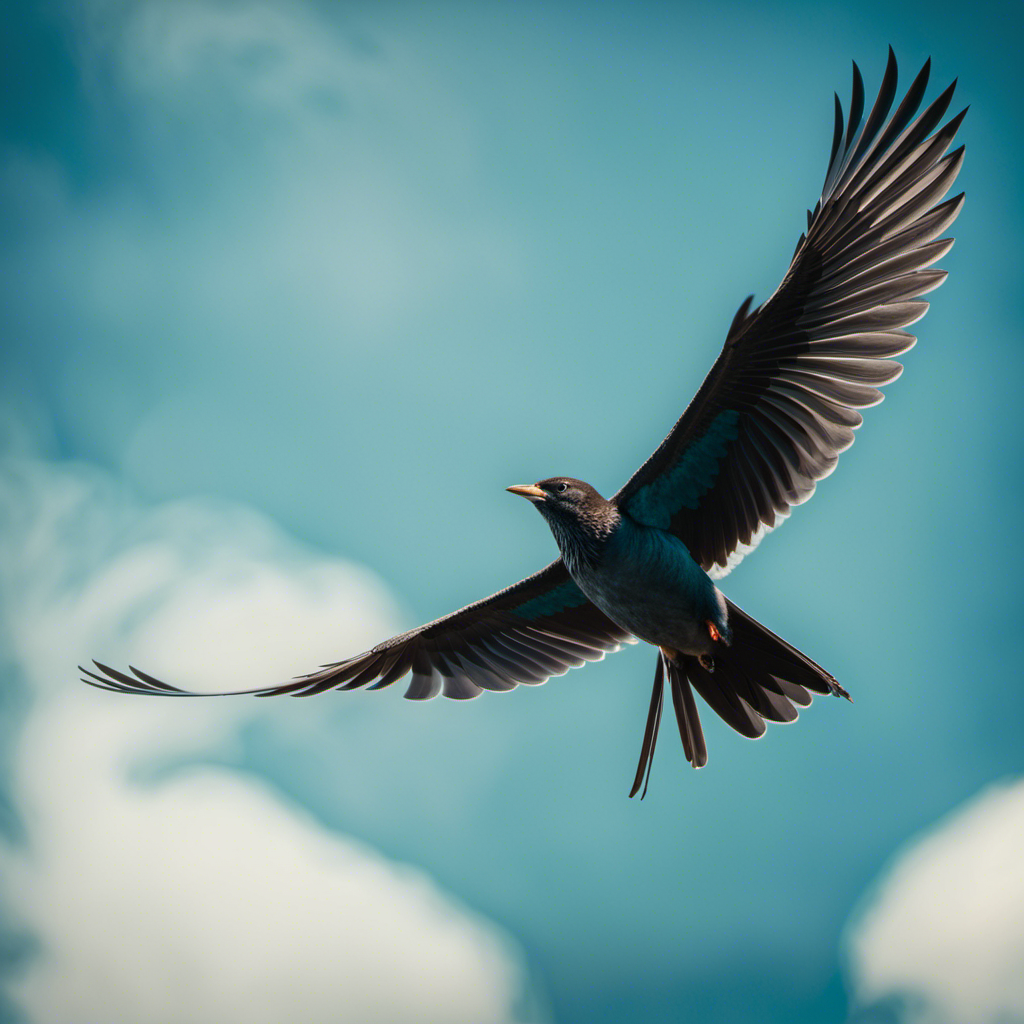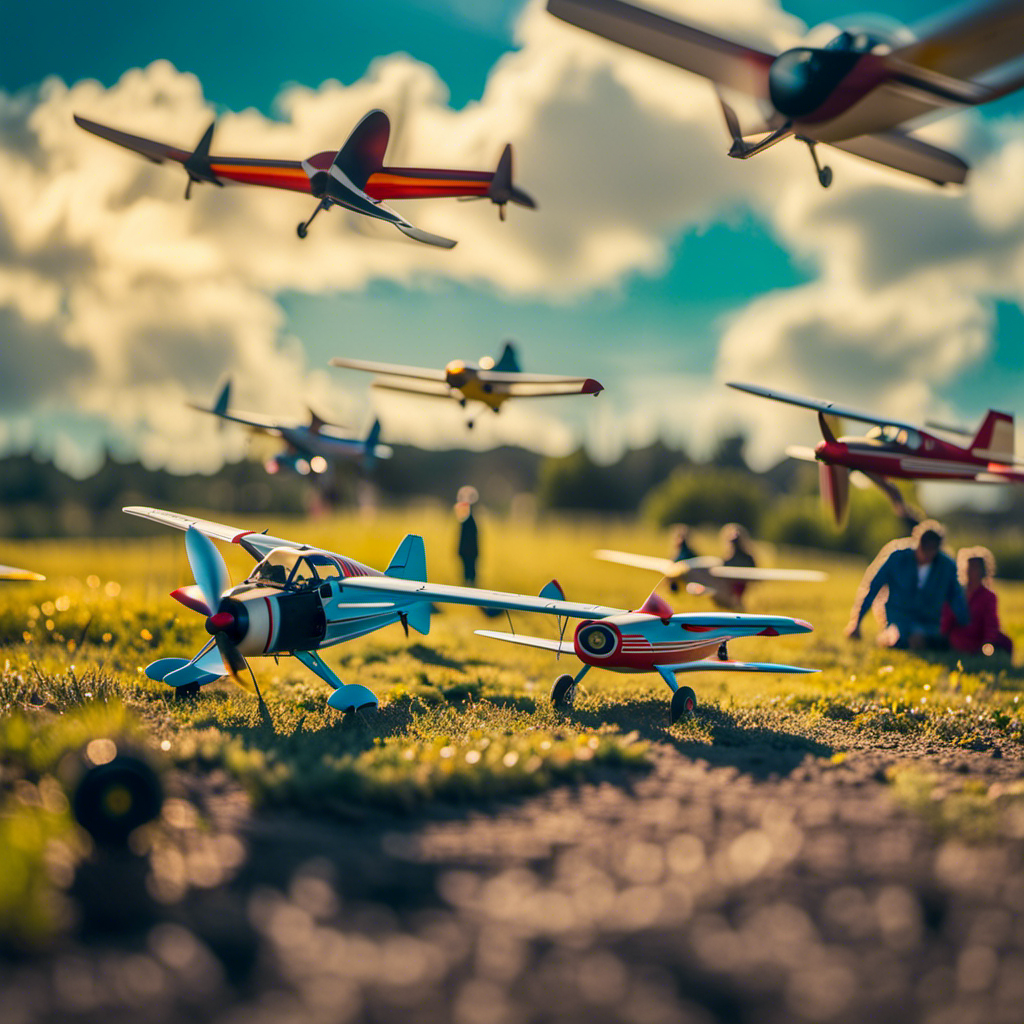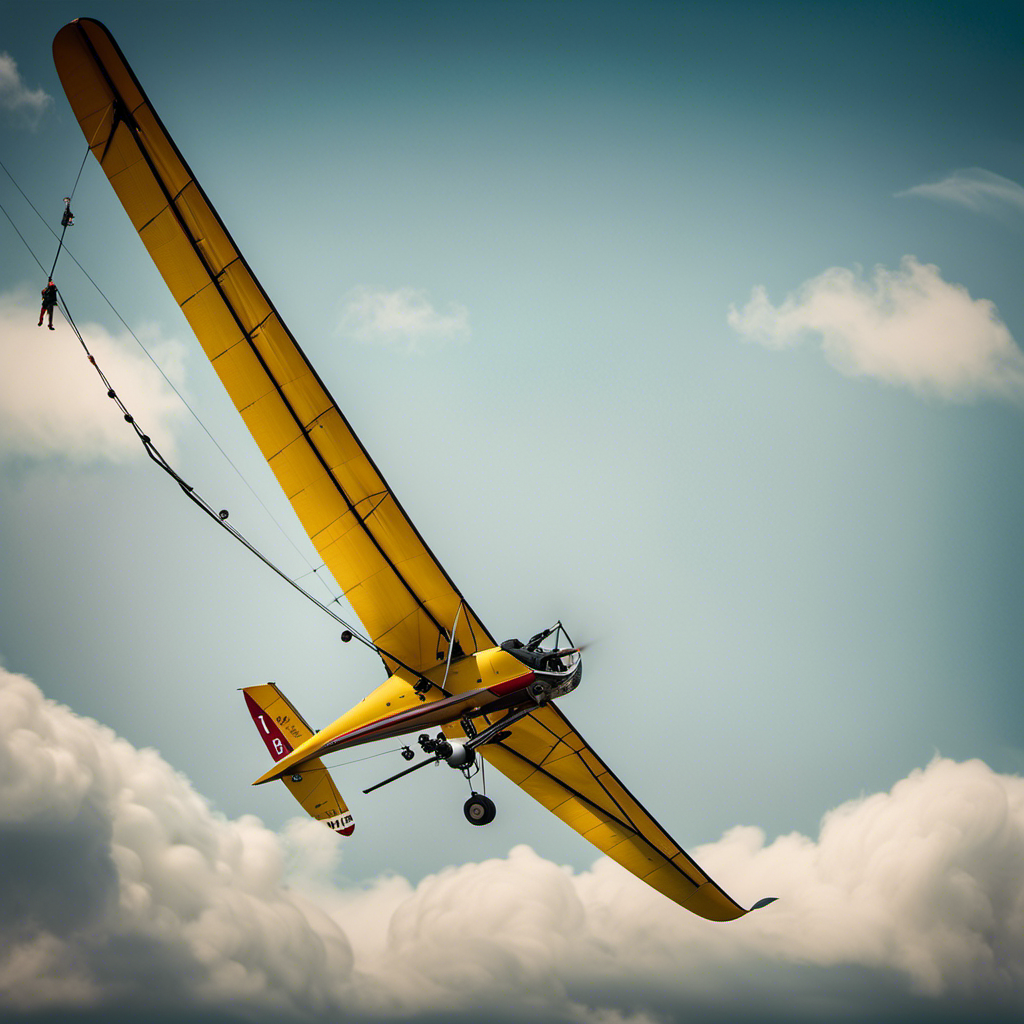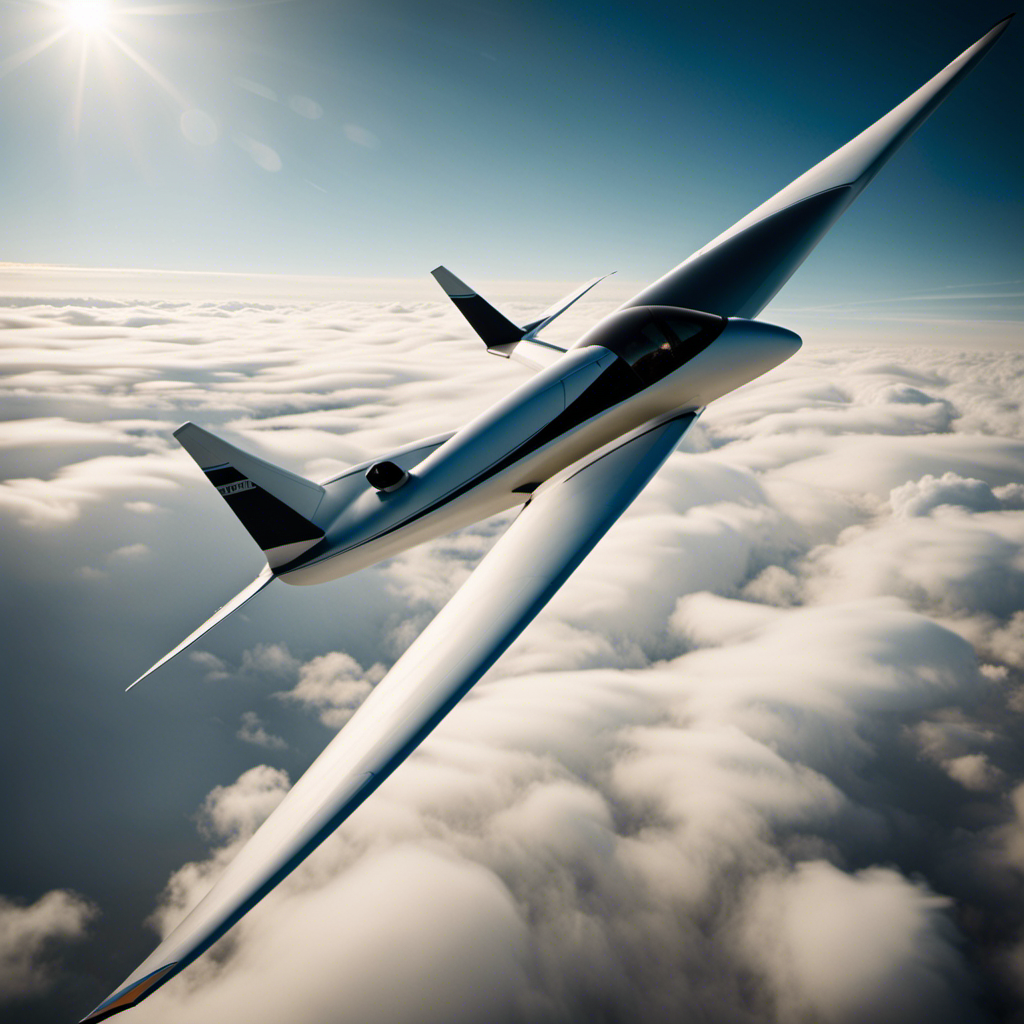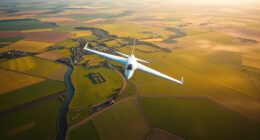When I look up into the sky, I am mesmerized by the elegant movements of a bird gliding smoothly through the atmosphere. Have you ever pondered what allows these splendid beings to accomplish flying in such a manner?
In this article, we will delve into the intricacies of bird soaring flight, exploring the basics of wing shape and adaptations, the techniques they employ to soar, and the remarkable energy conservation that occurs during their journeys.
Get ready to embark on a scientific journey into the fascinating world of bird flight.
Key Takeaways
- Birds use wings for soaring flight
- Soaring flight involves taking advantage of thermals and updrafts
- Wing shape and adaptations, such as wing loading and aspect ratio, affect bird flight
- Navigation and migration in birds rely on celestial navigation, landmark recognition, and magnetic sensitivity.
The Basics of Bird Flight
Birds use their wings to achieve soaring flight. The wing structure of birds is highly specialized for efficient flight. The primary flight feathers are located at the distal end of the wing, providing lift and propulsion. These feathers are asymmetrical, with a thicker leading edge and a thinner trailing edge, which helps to generate lift by creating a pressure difference between the upper and lower surfaces of the wing.
Additionally, the wing is shaped in a way that allows for the formation of an airfoil, which further enhances lift production. Flight mechanics play a crucial role in bird flight as well. Birds generate lift by flapping their wings in a downward and forward motion, creating an upward force. They also adjust the angle of their wings and tail to control their direction and speed. This allows birds to maneuver through the air with precision and efficiency.
Transitioning into the subsequent section about ‘wing shape and adaptations,’ we can further explore how different bird species have evolved unique wing shapes to suit their specific flight needs.
Wing Shape and Adaptations
When studying bird flight, it is important to consider the wing loading and aspect ratio. These factors determine how much weight a bird’s wings can support and the ratio of its wingspan to their average width, respectively.
Another crucial factor is wing morphology and flexibility. This aspect affects the bird’s maneuverability and ability to adapt to different flight behaviors.
Additionally, the structure and function of feathers play a significant role in bird flight. Feathers provide lift, insulation, and aid in flight control.
Overall, understanding these concepts is essential for comprehending the mechanics of bird flight.
Wing Loading and Aspect Ratio
Aspects such as wing loading and aspect ratio greatly affect a bird’s soaring flight. Wing loading refers to the weight of the bird divided by the area of its wings. The higher the wing loading, the more weight the wings need to support, which can impact the bird’s ability to generate lift.
Aspect ratio, on the other hand, is the ratio of the wingspan to the average width of the wings. Birds with higher aspect ratios have longer, narrower wings, which can improve their aerodynamic efficiency and lift generation.
These two factors play a crucial role in determining a bird’s ability to soar and stay aloft for long periods. Understanding the relationship between wing loading and aspect ratio is essential for studying bird flight dynamics.
Transitioning to the next section, wing morphology and flexibility also contribute to a bird’s soaring capabilities.
Wing Morphology and Flexibility
Wing morphology and flexibility greatly impact a bird’s ability to glide through the air. The shape and structure of a bird’s wings determine the efficiency and maneuverability of its flight.
Birds with longer, narrower wings, such as hawks and falcons, have a higher aspect ratio, which allows for faster and more efficient flight. On the other hand, birds with shorter, broader wings, like owls and pigeons, have a lower aspect ratio, giving them better maneuverability.
Wing flexibility also plays a crucial role in flight performance. Flexible wings can change shape during flight, allowing birds to adjust their lift and drag forces. This adaptability is especially important for birds that need to navigate tight spaces or perform quick maneuvers.
Understanding the relationship between wing morphology and flexibility is essential for studying bird flight. With this in mind, we can now explore the intricate structure and function of feathers.
Feather Structure and Function
Feathers are an essential component of a bird’s anatomy, contributing to its ability to glide through the air. They come in a variety of colors, ranging from vibrant hues to subtle shades, which serve multiple functions. Feather coloration can play a role in species recognition, courtship displays, and camouflage.
The growth and molting of feathers is a dynamic process, as birds continually replace old, worn-out feathers with new ones. Feather growth is regulated by specialized structures called follicles, which are located beneath the bird’s skin. Molting, the shedding of old feathers, occurs in a cyclical pattern and allows for the maintenance of feather quality and functionality.
Understanding the intricacies of feather structure and function provides insight into the remarkable capabilities of birds in flight.
Transitioning to the subsequent section about soaring techniques, birds utilize various strategies to achieve sustained flight without explicitly following a step-by-step process.
Soaring Techniques
You can maximize your bird’s soaring flight by utilizing efficient techniques.
Birds have developed various strategies to take advantage of the natural phenomena in their environment, such as thermals and updrafts.
Thermals are columns of warm air that rise from the ground due to heating by the sun. By circling within these thermals, birds can gain altitude and conserve energy.
Updrafts, on the other hand, are created by wind encountering an obstacle like a hill or cliff. Birds can use dynamic soaring to harness the upward force generated by these updrafts.
Another technique is ridge lift, where birds fly close to the ridge of a hill or mountain to ride the upward-moving air.
These techniques allow birds to soar effortlessly and cover great distances. By understanding and employing these techniques, birds can conserve energy during flight and increase their overall efficiency.
Energy Conservation in Flight
To conserve energy during flight, it’s important to understand and utilize efficient techniques. These include dynamic soaring, circling in thermals, and riding ridge lift.
Dynamic soaring is a technique where birds use the wind gradient at different altitudes to gain energy. By flying close to the surface and then quickly ascending to higher altitudes, birds can take advantage of the varying wind speeds and directions. This allows them to gain momentum and conserve energy.
Thermal soaring, on the other hand, involves circling in rising columns of warm air called thermals. Birds can detect these thermals using their keen senses and use them to gain altitude without much effort.
Navigation and Migration
In order to successfully navigate and migrate long distances, it’s crucial for birds to have a strong sense of direction and the ability to recognize landmarks along their route. The process of bird migration involves several remarkable navigational strategies, including celestial navigation.
Here are four fascinating aspects of bird migration:
-
Magnetic Sensitivity: Birds have the ability to sense the Earth’s magnetic field, allowing them to orient themselves in the correct direction during migration.
-
Sun and Star Navigation: Birds can use the position of the sun and stars to determine their direction of travel. They have an internal compass that helps them stay on course.
-
Landmark Recognition: Birds are skilled at recognizing landmarks, such as mountains, rivers, and coastlines, which they use as visual cues to navigate and stay on track.
-
Innate Navigation Abilities: Many migratory birds are born with an innate ability to navigate long distances. They possess an internal map that guides them along their migration route.
Understanding these navigation techniques is crucial to comprehend the impressive feats of bird migration. As we delve into the next section on bird flight speed and agility, we will explore how these skills contribute to their incredible aerial abilities.
Bird Flight Speed and Agility
Take a moment to consider the impressive speed and agility with which birds navigate the skies. Bird flight maneuverability is a fascinating aspect of avian biology, allowing these creatures to perform intricate aerial acrobatics. One factor that greatly contributes to their maneuverability is their wing loading, which is the ratio of a bird’s body weight to the size of its wings. Birds with lower wing loading, such as hummingbirds, have the ability to hover and change direction quickly, while birds with higher wing loading, like eagles, exhibit powerful soaring capabilities. To further illustrate the diverse range of bird flight maneuverability, consider the following table:
| Bird Species | Wing Loading (kg/m²) |
|---|---|
| Hummingbird | 0.1 |
| Sparrow | 2.5 |
| Falcon | 10 |
| Albatross | 20 |
| Eagle | 25 |
Understanding the intricacies of bird flight maneuverability is crucial in studying the aerodynamics of gliding, which will be explored in the subsequent section.
Aerodynamics of Gliding
When discussing the aerodynamics of gliding, it’s important to understand the key points of lift and drag forces, angle of attack, and lift coefficient, as well as stall and glide ratios.
Lift and drag forces play a crucial role in determining the ability of an object to stay airborne. The angle of attack and lift coefficient are key factors in optimizing lift production.
Furthermore, the stall and glide ratios are essential in understanding the efficiency and performance of a gliding aircraft.
Lift and Drag Forces
You can feel the lift and drag forces as you watch a bird soaring through the sky. The lift generation is a crucial aspect of bird flight. Birds achieve lift by creating a pressure difference between the upper and lower surfaces of their wings. This is accomplished through the unique shape of their wings, which is optimized for generating lift.
Additionally, birds reduce drag by maintaining a streamlined body shape and by tucking their legs and tail feathers close to their body during flight. These adaptations minimize the resistance encountered by the bird as it moves through the air.
Understanding the lift and drag forces acting on a bird during flight provides valuable insights into the aerodynamics of soaring. By studying these forces, we can further explore the relationship between the angle of attack and the lift coefficient, which will be discussed in the next section.
Angle of Attack and Lift Coefficient
To understand the relationship between the angle of attack and the lift coefficient, it’s important to analyze how these two factors interact during the flight of a bird.
The angle of attack refers to the angle between the bird’s wings and the oncoming airflow. It directly affects the lift coefficient, which is a measure of the efficiency of a bird’s wings in generating lift.
As the angle of attack increases, the lift coefficient also increases, up to a certain point. Beyond this point, the angle of attack becomes too steep, causing the airflow to separate from the wing and resulting in a decrease in lift.
Understanding this relationship is crucial for birds to maintain stable flight and optimize their lift production.
Now, let’s delve into the topic of stall and glide ratios, which further elucidates the intricacies of bird soaring flight.
Stall and Glide Ratios
The stall and glide ratios provide valuable insight into the efficiency of a bird’s flight. Stall speed is the minimum speed at which a bird can maintain level flight, while glide ratio is the distance a bird can travel horizontally for every unit of altitude lost.
These ratios are influenced by various factors, including wing shape, size, and wing loading. Birds with higher stall speeds generally have lower glide ratios, indicating less efficient flight. However, some bird species have evolved to exploit thermal currents, which can significantly increase their glide ratios.
Flight Adaptations in Different Bird Species
Birds have developed various flight adaptations to enable soaring in different species. These adaptations allow them to efficiently navigate the skies and take advantage of air currents.
Some of the key flight adaptations in bird species include:
-
Wing Shape: Birds have evolved different wing shapes to suit their specific flight needs. For example, long, slender wings are ideal for soaring birds like eagles, allowing them to stay aloft for extended periods.
-
Feather Structure: The structure of feathers plays a crucial role in flight. Birds have lightweight and flexible feathers that provide lift and control during flight. These feathers are also capable of self-maintenance, ensuring optimum flight performance.
-
Hollow Bones: Birds have hollow bones that reduce their overall weight, making it easier for them to take off and stay airborne. This adaptation also improves maneuverability during flight.
-
Efficient Respiratory System: Birds have a highly efficient respiratory system that enables them to extract more oxygen from the air. This adaptation ensures a continuous supply of oxygen to the flight muscles, allowing for sustained flight.
These flight adaptations have allowed birds to conquer the skies and explore various environments.
Transitioning to the subsequent section on flight performance and evolution, these adaptations have played a crucial role in shaping the remarkable flying abilities of different bird species.
Flight Performance and Evolution
Flying is a remarkable ability that has evolved over time, allowing birds to efficiently navigate the skies and explore diverse environments. Flight mechanics and flight efficiency are crucial factors that contribute to a bird’s ability to soar effortlessly through the air. By understanding the intricacies of bird flight, scientists have been able to uncover the secrets behind their remarkable performance.
One aspect of flight mechanics that plays a significant role in flight efficiency is wing morphology. Different bird species have adapted their wings to suit their specific needs, resulting in a wide range of wing shapes and sizes. For instance, birds with long, narrow wings, such as falcons, are built for speed and maneuverability, while birds with broader wings, like eagles, are designed for soaring and gliding.
To further illustrate the diversity of bird wings, consider the following table:
| Bird Species | Wing Shape | Wing Span (cm) |
|---|---|---|
| Peregrine Falcon | Pointed | 80-120 |
| Bald Eagle | Broad | 180-240 |
| Albatross | Long and Narrow | 250-340 |
| Hummingbird | Elongated | 80-100 |
| Sparrow | Rounded | 60-80 |
Appreciating the Beauty of Bird Flight
Take a moment to observe the graceful movement and elegant patterns displayed by these magnificent creatures as they glide effortlessly through the sky. Appreciating bird behavior and flight patterns is an opportunity to marvel at the wonders of nature.
Birds have evolved unique adaptations that allow them to achieve impressive feats of flight. Their wings, specialized for different purposes, enable them to soar, hover, and maneuver with precision. The way they use air currents and thermals to effortlessly stay aloft is truly remarkable.
Birds exhibit a variety of flight patterns, from the smooth gliding of raptors to the agile acrobatics of hummingbirds. These flight patterns are influenced by factors such as wing shape, wing loading, and aerodynamic principles.
Frequently Asked Questions
Do all bird species have the ability to soar in flight?
Not all bird species have the ability to soar in flight. Soaring flight is a specialized form of flight where birds use rising air currents to stay aloft without flapping their wings. Some species, like eagles and hawks, are known for their soaring abilities.
How do birds conserve energy while soaring?
Birds in thermals use the aerodynamics of their flight to conserve energy. They find rising air currents and soar effortlessly, adjusting their wing positions to maintain altitude and minimize exertion.
What factors determine a bird’s flight speed and agility?
Factors such as wing shape, size, and muscle strength determine a bird’s flight speed and agility. The wing’s aspect ratio, camber, and wing loading all contribute to the bird’s ability to maneuver and maintain high speeds while soaring.
How do different bird species adapt their flight techniques?
Different bird species adapt their flight techniques through various adaptations, including wing morphology. For example, the albatross has long, narrow wings, which allow it to soar effortlessly for long distances, covering up to 10,000 miles in a single journey.
What is the evolutionary history of bird flight?
The evolutionary history of bird flight involves various adaptations and is supported by fossil evidence. Through natural selection, birds developed specialized wings and feathers that allowed them to soar through the air with efficiency and precision.
Conclusion
In conclusion, studying bird flight is truly fascinating. The intricate wing shape and adaptations allow birds to soar effortlessly through the sky, conserving energy while navigating and migrating long distances.
One interesting statistic to note is that some bird species can fly for hours without flapping their wings even once, relying solely on air currents and thermals for propulsion. This remarkable ability showcases the incredible flight performance and evolution of birds.
Understanding and appreciating the beauty of bird flight is a testament to the wonders of nature.
